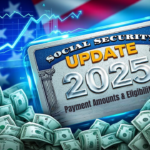In an effort to assist Americans who are struggling with rising living costs and economic challenges, new direct payments ranging from $1,500 to $3,250 have been approved for distribution this month. These payments are a part of various relief programs designed to ease the financial burden on eligible individuals and families. Here’s everything you need to know about these payments and how you can check if you qualify.
Understanding the Payments
This month’s direct payments have been allocated to support those who need it most. The amounts of $1,500, $2,300, and $3,250 vary based on factors like your income level, family size, and location. Here are the key details:
$1,500 Payment:
This payment is mainly targeted at low-income individuals who meet certain financial thresholds. It is designed to provide relief for those who may be struggling with everyday expenses such as groceries, utilities, or rent.
$2,300 Payment:
This amount is geared towards families with children or single parents who have been facing financial difficulties. The higher payment is meant to help with childcare costs or other family-related expenses. If you have dependents or have experienced a significant financial setback in the past year, you might be eligible.
$3,250 Payment:
This largest payment is intended for households with more significant financial needs, including those who have faced severe economic hardships due to job loss, medical bills, or other emergencies. It’s often targeted at those who qualify for additional assistance, such as SNAP benefits or Medicaid, or have a disability or other qualifying circumstances.

Eligibility Criteria
To ensure fairness and targeted assistance, these payments are based on income levels, family size, and other factors. Here’s how you can determine if you’re eligible:
- Income Limits: Your household income will be the main factor. Individuals or families who earn below a specific threshold may be eligible for the $1,500 or $2,300 payments, while those who have more significant needs may qualify for the $3,250 payment.
- Family Size: If you have children or dependents, you might be eligible for a higher payment. Families with more children are generally eligible for larger amounts.
- Residency: The program is generally targeted to residents in the United States, although specific states may have additional requirements or differences in eligibility.
- Social Security, SSI, and SSDI: If you are receiving Social Security, SSI, or SSDI benefits, you may qualify for these payments. This is especially true for individuals with low income or disabilities.
- Special Circumstances: Certain special situations, like medical emergencies or job loss, might automatically qualify you for the higher payment amounts.

How to Apply and Get Your Payment
If you believe you are eligible for one of these payments, here are the steps you can take to apply or ensure you receive the payment:
- Check Your Eligibility Online: Most states or programs have online portals where you can enter your personal and financial information to check if you qualify for the payments.
- Fill Out the Necessary Forms: If you are not automatically enrolled in the program, you may need to fill out an application to confirm your eligibility. This may include proof of income, dependents, or other qualifying circumstances.
- Direct Deposit or Check: Depending on the program, payments may be issued via direct deposit to your bank account or mailed as a check to your home address.
- Contact Your Local Authority: If you are unsure about the process or need assistance, contact your local social services office or state government for detailed instructions.
Conclusion
With the approval of these payments ranging from $1,500 to $3,250, many Americans will receive much-needed financial relief. However, eligibility is based on income, family size, and other factors, so it’s important to check if you qualify. Whether you are a single parent, low-income individual, or someone facing financial hardship, these payments can provide some temporary relief.
Be sure to check your eligibility online and apply as needed to ensure you receive your payment.
FAQs
1. How do I know if I qualify for these payments?
Eligibility depends on your income level, family size, and specific financial circumstances. You can check your eligibility by visiting the online portal of your state or contacting local authorities.
2. When will the payments be issued?
The payments are being issued this month. Exact dates may vary by state and program, but most payments should arrive within a few weeks after approval.
3. Can I receive more than one payment?
It’s possible to qualify for multiple payments depending on your family size, income level, and special circumstances. For instance, you might qualify for both the $1,500 payment and the $2,300 payment if you meet the criteria.
4. Do I need to apply for these payments?
In some cases, payments will be issued automatically to those who meet the eligibility requirements. However, if you need to apply, you may be required to submit proof of income, family size, and other relevant documents.
5. What if I didn’t receive my payment?
If you believe you are eligible but did not receive your payment, you should contact your state’s social services department or the relevant program administrators to investigate the issue and determine what steps to take next.







